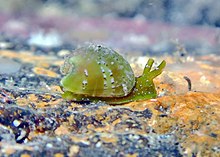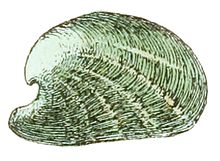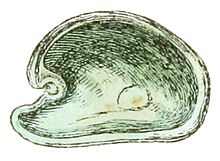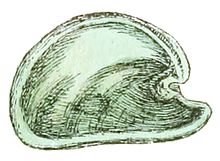Juliidae
| Juliidae Temporal range:
| |
|---|---|

| |
| Julia exquisita | |

| |
| A drawing of theshell(the exterior of the rightvalve) of a taxon named "Julia borbonica" | |
| Scientific classification | |
| Domain: | Eukaryota |
| Kingdom: | Animalia |
| Phylum: | Mollusca |
| Class: | Gastropoda |
| Subclass: | Heterobranchia |
| Infraclass: | Euthyneura |
| Superorder: | Sacoglossa |
| Superfamily: | Oxynooidea |
| Family: | Juliidae E. A. Smith,1885[1] |
| Synonyms | |
|
PrasinidaeStoliczka, 1871(Prasinidae is a senior, but unused, synonym of Juliidae) | |
Juliidae,common namethebivalved gastropods,is afamilyof minutesea snails,marinegastropodmollusksormicromollusksin the superfamilyOxynooidea,anopisthobranchgroup.[2]
These aresacoglossan(sap-sucking) sea snails, and many of them are green in color.
These snails are extremely unusual in that their shells consist of two separate hinged pieces orvalves.The valves are joined by a ligament, and look nothing like a normalsnail shell;instead the valves look almost exactly like the two hinged valves of aclam,abivalvemollusk, which is a related but very different class of mollusks.
Up until the mid-20th century, the Juliidae were known only fromfossilshells, and not surprisingly, these fossils were interpreted as being the shells of bivalves.Julia,which is the type genus of the family, was named in 1862 byAugustus Addison Gould,who described it as a bivalve genus. Juliidae are known from theEoceneperiod to the Recent, but they probably first appeared during thePaleocene.[3]
Taxonomy as "bivalves"
[edit]These bivalved gastropods were for a long time only known fromfossilsand dead material. Because of this, they had been described as being somewhat atypicalbivalves.In the late 19th century they were classified among the bivalves, within the familyMytilidae,the mussels.[4]
The similarity of the shells of Juliidae to those of bivalves doesnotmean that these snails are closely related to bivalves; this is an example ofconvergent evolution.
Discovery of live animals
[edit]Until the mid-20th century, these creatures were still considered to bebivalves.Then, in 1959, living individuals of one species were collected on thegreen alga,Caulerpa,inJapan.It was immediately clear that these animals were, in fact, unusual gastropods with a two-part shell. The first-discovered live species of bivalved gastropod wasTamanovalva limax,described byKawaguti&Baba(1959).[5]
Once the habitat, appearance, and life habits of these very small and inconspicuous animals were understood, researchers in subsequent years were able to find a number of other species and genera in different parts of the world, also living on various species ofCaulerpa.
2005 taxonomy
[edit]This family is within the superorderSacoglossa(according to thetaxonomy of the Gastropoda by Bouchet & Rocroi, 2005).
The family Juliidae consists of the following subfamilies (according to thetaxonomy of the Gastropoda by Bouchet & Rocroi, 2005):
- subfamilyJuliinaeE. A. Smith, 1885 - synonym: Prasinidae Stoliczka, 1871
- subfamilyBertheliniinaeKeen & A. G. Smith, 1961[6]- synonym: Tamanovalvidae Kawaguti & Baba, 1959
- † (fossil) subfamilyGougerotiinaeLe Renard, 1980[7]
Description
[edit]

As Tryon (1884)[4]wrote in his description of the genusJulia:the shell is oblong, thick, and cordiform. The valves are closed, the margins entire and the valves are inequilateral. The lunule is deep circular, projecting into the interior of the rightvalve,the left valve is in the same place furnished with dentiform tubercles. The hinge line is simple and arched. Theligamentis external and narrow. There are two muscle scars which are unequal and subcentral.
These animals have twovalves,and the soft parts can be completely withdrawn inside the shell.[8]The two valves are usually thin and translucent.
In the genusTamanovalvathere is aprotoconchon theapexof the left valve. This is clearly visible in the left valve ofTamanovalva babai.[9]
The body of the live animals is in most cases green (as it is in manysacoglossans), and in many species the individual appears green in totality. This, combined with the very small overall size, makes the animal hard to see on the green algae on which it lives. This ability serves ascrypsis,especially as cryptic coloration (camouflage). In two species[1]and[2]the camouflage is even more complete: the mantle of the animal is patterned in a way that closely resembles the structure of the alga on which it lives.
The empty valves of the shells of these animals are in some cases green, in other cases brownish-green or yellow, and in yet others, colorless. The speciesJulia zebrahas shells that are finely striped with brown and blotched with white.[10]
Ecology
[edit]Distribution
[edit]Species in this family occur in alltropical zone seasand alltemperate zoneseas.[8]
Life cycle
[edit]After hatching, the juvenile snails immediately take their place on algae (the larval phase ofveligeris extremely short).[11]
Feeding habits
[edit]Juliidae feed ongreen algae[8]of the genusCaulerpa.Some species of Juliidae feed only on one species ofCaulerpa;others feed on multiple species of this green alga.
Genera
[edit]Thetype genusof the family Juliidae isJuliaGould, 1862.
Based on a classification by Jensen (1996),[12]three recent genera were recognized in the family Juliidae:[13]JuliaGould, 1862;BertheliniaCrosse, 1875;TamanovalvaKawaguti & Baba, 1959.
While Jensen (2007)[14]recognized two recent genera with a few subgenera in the genusBerthelinia.Recent species listed here are based on Jensen (2007),[14]fossil genera and species are based on Le Renard (1996):[3]
Juliinae
[edit]- JuliaGould, 1862 - synonym:PrasinaDeshayes, 1863
- (recent)Julia burniSarma, 1975
- (invalid[12]recent species)Julia cornuta(De Folin, 1867)
- (invalid[12]recent species)Julia equatorialisPilsbry & Olsson, 1944
- (recent)Julia exquisitaGould, 1862[15]- this species was mentioned in report by theChallenger expedition[16][17]
- (recent)Julia japonicaKuroda & Habe, 1951[17][18]
- (recent)Julia mishimaensisKawaguti & Yamasu, 1982[17]
- (recent)Julia thecaphora(Carpenter, 1857) - a probable[19]synonym isJulia zebraKawaguti, 1981[20]
- (recent)Julia zebraKawaguti 1981
- (fossil)CandiniaLe Renard J., Sabelli B. & Taviani M. 1996[3]
- (fossil)Candinia pliocaenicaLe Renard J., Sabelli B. & Taviani M. 1996[3]- fromlower PliocenenearSienain Italy.
- (fossil)Candinia krachi(Baluk & Jakubowski, 1968) - synonym:Berthelinia krachiBaluk & Jakubowski, 1968
Bertheliniinae
[edit]- BertheliniaCrosse, 1875 - type genus of the subfamily Bertheliniinae
- subgenusBertheliniaCrosse, 1875
- (recent)Berthelinia caribbeaEdmunds, 1963[11]
- (recent)Berthelinia chloris(Dall, 1918)[21]
- (invalid[14]recent species)Berthelinia corallensisHedley, 1920
- (recent)Berthelinia darwiniJensen, 1997
- (recent)Berthelinia ganapatiSarma, 1975
- (recent)Berthelinia pseudochlorisKay, 1964[22][23]
- (recent)Berthelinia rottnestiJensen, 1993
- (recent)Berthelinia schlumbergeriDautzenberg, 1895
- (recent)Berthelinia waltairensisSarma, 1975
- (fossil)Berthelinia elegansCrosse, 1875
- subgenusMidorigai:synonym ofBertheliniaCrosse, 1875
- (recent)Berthelinia australis(Burn, 1960) - synonym:Midorigai australisBurn, 1960[24]
- subgenusTamanovalvaKawaguti & Baba, 1959: synonym ofBertheliniaCrosse, 1875
- (recent)Berthelinia babai(Burn, 1965) - synonym:Tamanovalva babaiBurn, 1965[9][25]
- (recent)Berthelinia fijiensis(Burn, 1966)[26]
- (recent)Berthelinia limax(Kawaguti & Baba, 1959) - synonym:Tamanovalva limaxKawaguti & Baba, 1959 - a type species of the subgenusTamanovalva[5][27]
- subgenusEdenttellina:synonym ofBertheliniaCrosse, 1875
- (recent)Berthelinia typica(Gatliff &Gabriel,1911) - synonym:Edenttellina typicaGatliff & Gabriel, 1911[28][29]
- subgenusBertheliniaCrosse, 1875
- (fossil?)AnomalomyaCossmann, 1887
- (fossil?)NamnetiaCossmann, 1906
- (fossil?)SquamuliniaLe Renard, 1989
Gougerotiinae
[edit]- (fossil)GougerotiaLe Renard, 1980 - type genus of the subfamily Gougerotiinae
- (fossil)Gougerotia orthodontaLe Renard, 1980
?subfamily
- (fossil)HemiplicatulaDeshayes, 1861
- (fossil?)Saintiade Raincourt, 1877
See also
[edit]References
[edit]This article incorporates public domain text from reference.[4]
- ^Smith E. A.(1885). "Report on the scientific results of the voyage ofH. M. S. Challenger".Zoology13(1): 269.
- ^MolluscaBase eds. (2021). MolluscaBase. Juliidae E. A. Smith, 1885. Accessed through: World Register of Marine Species at:http://marinespecies.org/aphia.php?p=taxdetails&id=196330on 2021-06-09 Taxonomic edit history
- ^abcdLe Renard J., Sabelli B. & Taviani M. (March 1996). "OnCandinia(Sacoglossa: Juliidae), a New Fossil Genus of Bivalved Gastropods ".Journal of Paleontology70(2): 230-235.JSTOR1306386
- ^abcGeorge Washington Tryon,Jr. (1884).Structural and systematic conchology: an introduction to the study of the Mollusca. Volume III.Philadelphia, published by the author,page 267.
- ^abKawaguti S.&Baba K.(1959). "A preliminary note on a two-valved sacoglossan gastropod,Tamanovalva limax,n. gen., n. sp., from Tamano, Japan ".Biological Journal Okayama University5(3-4): 177-184.
- ^Keen & Smith A. G. (1961).Proceedings of the California Academy of Sciences,ser. 4,30(2): 50.
- ^Le Renard J. (1980).Bulletin d'Information des Géologues du Bassin de Paris17(2): 23.
- ^abc(in Czech)de Bruyne R. H. (2004).Encyklopedie ulit a lastur.Rebo Productions, 336 pp.,ISBN80-7234-288-6,page 223.
- ^abRudman W. B.(16 October 2011)."Tamanovalva babaiBurn, 1965 "Archived2010-06-15 at theWayback Machine.Sea Slug Forum. Australian Museum, Sydney, accessed 10 May 2009.
- ^"Julia zebra: Shell".
- ^abRudman W. B. (4 October 2003)."Berthelinia caribbeaEdmunds, 1963 "Archived2008-05-02 at theWayback Machine.Sea Slug Forum. Australian Museum, Sydney, accessed 10 May 2009.
- ^abcJensen K. R. (1996). "Phylogenetic systematics and classification of the Sacoglossa (Mollusca, Gastropoda, Opisthobranchia)".Philosophical Transactions of the Royal Society London B Biological Sciences351(1335): 91-122.doi:10.1098/rstb.1996.0006.
- ^Händeler K., Grzymbowski Y. P., Krug P. J. & Wägele H. (2009). "Functional chloroplasts in metazoan cells - a unique evolutionary strategy in animal life".Frontiers in Zoology6:28.doi:10.1186/1742-9994-6-28PMID19951407.
- ^abcJensen K. R. (November 2007)."Biogeography of the Sacoglossa (Mollusca, Opisthobranchia)"Archived2013-10-05 at theWayback Machine.Bonner zoologische Beiträge55(2006)(3-4): 255–281.
- ^Rudman W. B. (4 October 2001)."Julia exquisita(Gould, 1862) "Archived15 June 2010 at theWayback Machine.Sea Slug Forum. Australian Museum, Sydney, accessed 10 May 2009.
- ^"ZOOLOGY Part XXXV".REPORT of the SCIENTIFIC RESULTS of the VOYAGE OF H.M.S. CHALLENGER DURING THE YEARS 1873-76.pp.269,270.Retrieved2024-01-31– via 19thCenturyScience.org.
•LINKED INDEX TO THE BOTANICAL AND ZOOLOGICAL REPORTSat theWayback Machine(archived 2023-06-07)
•ZOOLOGY Part XXXVat theWayback Machine(archived 2023-06-01)
•Contentsat theWayback Machine(archived 2023-04-01)
•Page 269at theWayback Machine(archived 2024-01-31)
•Page 270at theWayback Machine(archived 2024-01-31) - ^abcBolland R. F. (2001)."Okinawan Opisthobranch of the WeekJulia exquisita".Last change of the page 12 March 2001.
- ^Poppe-Images.com,accessed 11 May 2009
- ^Pittman C. (10 October 2001)."Julia zebraKawaguti, 1981 "Archived15 June 2010 at theWayback Machine.Sea Slug Forum. Australian Museum, Sydney, accessed 10 May 2009.
- ^Kawaguti S. (1981). "A new bivalved gastropodJulia zebra".Bulletin of the Kawasaki Paramedical College1:9-13.
- ^Miller M. D. (2002)."Berthelinia chloris".The Slug Site, accessed 11 May 2009.
- ^Kay E. A.(1964). "A new species ofBertheliniaand its associated sacoglossans in the Hawaiian Islands ".Proceedings of the Malacological Society of London36:191-197.abstract.
- ^Pittman C. & Fiene P. (2009)."Berthelinia pseudochloris".Sea Slugs of Hawaii, last change of the page 27 January 2009, accessed 10 May 2009.
- ^Rudman W. B. (16 October 2001)."Midorigai australisBurn, 1960 "Archived2010-06-15 at theWayback Machine.Sea Slug Forum. Australian Museum, Sydney, accessed 10 May 2009.
- ^Burn R. F. (1965). "Rediscovery and taxonomy ofEdenttellina typicaGatliff and Gabriel ".Nature206(4985): 735-736.
- ^Burn R. (1966). "The Opisthobranchs of a caulerpan microfauna from Fiji".Proceedings of the Malacological Society London37:45.abstract
- ^Rudman W. B. (11 March 2002)."Tamanovalva limaxKawaguti & Baba, 1959 "Archived2010-06-15 at theWayback Machine.Sea Slug Forum. Australian Museum, Sydney, accessed 10 May 2009.
- ^Gatliff J. H. & Gabriel C. J. (1911). "On some new species of Victorian marine mollusca".Proceedings of the Royal Society of Victoria24:189-192.
- ^Rudman W. B. (16 October 2001)."Edenttellina typicaGatliff & Gabriel, 1911 "Archived2010-06-15 at theWayback Machine.Sea Slug Forum. Australian Museum, Sydney, accessed 10 May 2009.
External links
[edit]- Cory Pittman & Pauline Fiene. 2009.Juliidae.Sea Slugs of Hawaii.
- Images of 4 species of Juliidae in Japan
- Photos ofJulia exquisita[permanent dead link]at Sea Slug Forum
- Detailed photos of the shell ofJulia exquisita[permanent dead link]at Sea Slug Forum
- (in Japanese)http://taxonomist.symphonic-net.com/contents/Others/Julia/julia!.html[permanent dead link]
